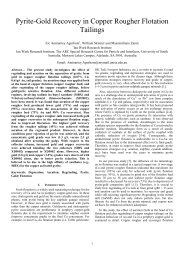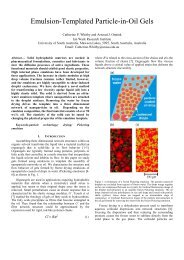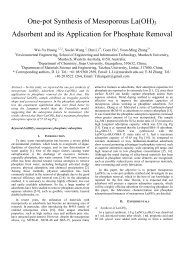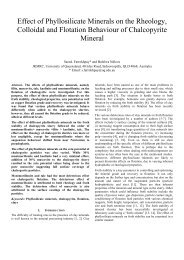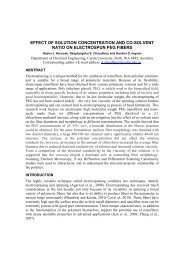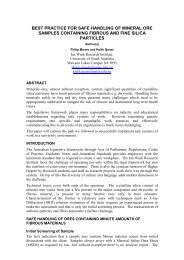Preparation of Coal Agglomerates Using a Water-in-Oil Emulsion
Preparation of Coal Agglomerates Using a Water-in-Oil Emulsion
Preparation of Coal Agglomerates Using a Water-in-Oil Emulsion
- No tags were found...
Create successful ePaper yourself
Turn your PDF publications into a flip-book with our unique Google optimized e-Paper software.
<strong>Preparation</strong> <strong>of</strong> <strong>Coal</strong> <strong>Agglomerates</strong> <strong>Us<strong>in</strong>g</strong> a<br />
<strong>Water</strong>-<strong>in</strong>-<strong>Oil</strong> <strong>Emulsion</strong><br />
K. van Netten 1 , R. Moreno-Atanasio 1 and K.P. Galv<strong>in</strong> 1<br />
1 Centre for Advanced Particle Process<strong>in</strong>g and Transport<br />
School <strong>of</strong> Eng<strong>in</strong>eer<strong>in</strong>g, The University <strong>of</strong> Newcastle, Callaghan, NSW 2308, Australia<br />
Email: kim.vannetten@uon.edu.au<br />
Abstract— The conventional oil agglomeration process<br />
utilises an immiscible organic liquid, such as diesel, to<br />
agglomerate coal <strong>in</strong> an aqueous suspension <strong>of</strong> coal and<br />
m<strong>in</strong>eral particles. With the application <strong>of</strong> agitation, the<br />
organic liquid selectively wets the surface <strong>of</strong> the coal and<br />
subsequently b<strong>in</strong>ds the coal particles together to form<br />
agglomerates. Dur<strong>in</strong>g this process, the m<strong>in</strong>eral matter<br />
rema<strong>in</strong>s f<strong>in</strong>ely dispersed and hence the coal agglomerates<br />
can be retrieved by pass<strong>in</strong>g the material over a screen.<br />
This process achieves high quality beneficiation <strong>of</strong> the f<strong>in</strong>e<br />
coal, and very effective dewater<strong>in</strong>g <strong>of</strong> the product. While<br />
this is a remarkably effective process the technology has<br />
not been adopted because <strong>of</strong> the very poor economics, due<br />
to the high cost <strong>of</strong> the oil. In this work an alternative<br />
immiscible b<strong>in</strong>d<strong>in</strong>g agent consist<strong>in</strong>g <strong>of</strong> a high <strong>in</strong>ternal<br />
phase (HIP) water-<strong>in</strong>-oil emulsion was used. This b<strong>in</strong>d<strong>in</strong>g<br />
agent provides the <strong>in</strong>terfacial functionality <strong>of</strong> the oil, with<br />
the space fill<strong>in</strong>g functionality provided by the stabilised<br />
water drops <strong>of</strong> the emulsion. Thus far, the HIP emulsion<br />
has successfully agglomerated f<strong>in</strong>e coal <strong>in</strong> an aqueous<br />
suspension and, <strong>in</strong> addition, has done so at a lower oil<br />
requirement than when pure diesel oil was used. A two-tothree<br />
fold reduction <strong>in</strong> organic liquid consumption was<br />
achieved when the HIP emulsion was used <strong>in</strong> the place <strong>of</strong><br />
pure diesel oil. Further reductions <strong>in</strong> the organic liquid<br />
consumption are anticipated <strong>in</strong> the future if improved<br />
methods <strong>of</strong> prepar<strong>in</strong>g the emulsion are realised.<br />
Keywords-oil agglomeration; beneficiation; coal; high<br />
<strong>in</strong>ternal phase emulsion<br />
I. INTRODUCTION<br />
The beneficiation <strong>of</strong> f<strong>in</strong>e coal has been a long stand<strong>in</strong>g<br />
problem <strong>in</strong> the coal process<strong>in</strong>g <strong>in</strong>dustry because the size <strong>of</strong> the<br />
particles means they are difficult and, <strong>in</strong> most cases,<br />
uneconomical to process. In the past, this f<strong>in</strong>e portion <strong>of</strong> the<br />
coal feed was simply discarded as waste and held <strong>in</strong>def<strong>in</strong>itely<br />
<strong>in</strong> tail<strong>in</strong>gs ponds. More recently, however, a greater focus has<br />
been placed on <strong>in</strong>creas<strong>in</strong>g efficiencies and decreas<strong>in</strong>g waste <strong>in</strong><br />
coal process<strong>in</strong>g and utilisation. Spiral concentrators and froth<br />
flotation mach<strong>in</strong>es have been used with some success to treat<br />
f<strong>in</strong>e coal particles although both technologies become less<br />
effective when a significant amount <strong>of</strong> ultra-f<strong>in</strong>e, or slimes,<br />
material (< 75 µm) is present <strong>in</strong> the feed [1, 2, 3]. Both<br />
technologies are also associated with high dewater<strong>in</strong>g costs as<br />
they require large volumes <strong>of</strong> water to process coal feeds [4].<br />
The problems encountered <strong>in</strong> the process<strong>in</strong>g <strong>of</strong> f<strong>in</strong>e coal are<br />
undeniably due to the small size <strong>of</strong> the particles and, therefore,<br />
the limited effect gravity has on them. As a direct solution to<br />
this problem, selective agglomeration, or oil agglomeration <strong>of</strong><br />
the f<strong>in</strong>e coal particles has been <strong>in</strong>vestigated numerous times <strong>in</strong><br />
the past. Selective agglomeration is the process by which an<br />
immiscible liquid, usually oil, is added to an aqueous<br />
suspension <strong>of</strong> coal and m<strong>in</strong>eral particles [5]. Upon the<br />
agitation <strong>of</strong> the suspension the oil preferentially wets and<br />
agglomerates the hydrophobic coal particles, leav<strong>in</strong>g the<br />
unwanted m<strong>in</strong>eral matter rema<strong>in</strong>s f<strong>in</strong>ely dispersed <strong>in</strong> the<br />
suspension. The coal can then be easily retrieved by pass<strong>in</strong>g<br />
the agglomerated suspension over a screen. The process <strong>of</strong> oil<br />
agglomeration, as applied to coal, has been shown to achieve<br />
excellent recovery <strong>of</strong> combustible material with a reasonable<br />
ash content. The process also has the ability to handle ultraf<strong>in</strong>e<br />
coal feeds. While these attributes make the process sound<br />
highly promis<strong>in</strong>g and beneficial, there has never been a fullscale,<br />
long term, implementation <strong>of</strong> this process. The<br />
dom<strong>in</strong>ant reason for this lack <strong>of</strong> development is the poor<br />
economics <strong>of</strong> the process due to the high cost <strong>of</strong> the oil<br />
required.<br />
This study revisited the process <strong>of</strong> oil agglomeration to test<br />
a novel modification that aimed to reduce the amount <strong>of</strong> oil<br />
required. The novel modification was the use <strong>of</strong> a high <strong>in</strong>ternal<br />
phase (HIP) water-<strong>in</strong>-oil emulsion as the immiscible liquid<br />
b<strong>in</strong>der, <strong>in</strong>stead <strong>of</strong> the pure oil conventionally used. A high<br />
<strong>in</strong>ternal phase emulsion is an emulsion <strong>in</strong> which the <strong>in</strong>ternal,<br />
disperse phase has a phase volume <strong>of</strong> greater than 0.74 [6].<br />
This is an unusual configuration as it is normally the<br />
cont<strong>in</strong>uous phase <strong>of</strong> an emulsion that has the higher phase<br />
volume. The HIP emulsion was considered as an alternative<br />
agglomerat<strong>in</strong>g agent as it provided the <strong>in</strong>terfacial functionality<br />
<strong>of</strong> the oil, with the space fill<strong>in</strong>g functionality provided by the<br />
stabilised water drops <strong>of</strong> the emulsion.<br />
As this is a novel modification, this study was a prelim<strong>in</strong>ary<br />
<strong>in</strong>vestigation <strong>in</strong>to the functionality <strong>of</strong> the HIP emulsion as a<br />
b<strong>in</strong>der. Initially, the ability <strong>of</strong> the HIP emulsion to form coal<br />
agglomerates was tested. As part <strong>of</strong> this test, the growth <strong>of</strong> the<br />
agglomerates with time was considered by plott<strong>in</strong>g the size<br />
distribution <strong>of</strong> a given coal sample for different times dur<strong>in</strong>g
the agitation <strong>of</strong> the suspension. The change <strong>in</strong> the volume<br />
weighted mean diameter with time was also measured.<br />
F<strong>in</strong>ally, a number <strong>of</strong> agglomeration experiments were carried<br />
out <strong>in</strong> which the performance <strong>of</strong> three different b<strong>in</strong>ders was<br />
compared: pure diesel oil, a HIP water-<strong>in</strong>-oil emulsion and a<br />
mixture <strong>of</strong> diesel and emulsifier. It was <strong>in</strong> these tests that the<br />
benefit <strong>of</strong> us<strong>in</strong>g the HIP emulsion as the b<strong>in</strong>der, as opposed to<br />
pure oil, could be elucidated.<br />
II.<br />
EXPERIMENTALS<br />
A. <strong>Preparation</strong> <strong>of</strong> the High Internal Phase <strong>Emulsion</strong><br />
The high <strong>in</strong>ternal phase emulsion was prepared prior to<br />
carry<strong>in</strong>g out the agglomeration experiments. In all<br />
experiments the emulsion was prepared such that the <strong>in</strong>ternal<br />
dispersed water phase made up 0.85 <strong>of</strong> the total mass <strong>of</strong> the<br />
emulsion. The cont<strong>in</strong>uous, oil, phase made up the rema<strong>in</strong>der<br />
<strong>of</strong> the emulsion and consisted <strong>of</strong> automotive diesel oil and<br />
50% by weight emulsifier. The emulsifier was an<br />
ethanolam<strong>in</strong>e derivative <strong>of</strong> polyisobutylene. To make the HIP<br />
emulsion, the water was added to the oil and emulsifier dur<strong>in</strong>g<br />
cont<strong>in</strong>uous mix<strong>in</strong>g supplied by a Russell Hobbs Hand Mixer<br />
(350 watt motor) set a maximum speed. To ensure phase<br />
<strong>in</strong>version did not occur dur<strong>in</strong>g the creation <strong>of</strong> the emulsion the<br />
water was added to the mixture <strong>in</strong> <strong>in</strong>crements. Each <strong>in</strong>crement<br />
<strong>of</strong> water was smaller than the orig<strong>in</strong>al volume <strong>of</strong> oil <strong>in</strong> the<br />
emulsion and the previous <strong>in</strong>crement was fully dispersed<br />
before the next was added. The mixture began as a transparent<br />
orange liquid and progressively turned lighter as more water<br />
was added, f<strong>in</strong>ally form<strong>in</strong>g an opaque, white and viscous<br />
substance. To further ref<strong>in</strong>e (disperse the <strong>in</strong>ternal water <strong>in</strong>to<br />
smaller and more uniform droplets) the emulsion was placed<br />
under a Heidolph RZR 2102 Control agitator for 40 m<strong>in</strong> at<br />
2000 rpm.<br />
agglomerated product rema<strong>in</strong>ed on top while the f<strong>in</strong>ely<br />
dispersed m<strong>in</strong>eral matter rema<strong>in</strong>ed <strong>in</strong> the flow <strong>of</strong> the water and<br />
formed the reject under the screen. The agglomerated product<br />
was submitted to a thorough wash to ensure any m<strong>in</strong>eral<br />
matter rema<strong>in</strong><strong>in</strong>g on the surface <strong>of</strong> the agglomerates was<br />
removed. The product and reject samples were then dried <strong>in</strong> an<br />
oven (set at 110 °C )and weighed as to calculate the yield<br />
achieved. The yield was def<strong>in</strong>ed as the fraction <strong>of</strong> the feed<br />
sample that was reta<strong>in</strong>ed as coal agglomerates on top <strong>of</strong> the<br />
screen. It should be noted that when the growth <strong>of</strong> the<br />
agglomerates was under <strong>in</strong>vestigation the agglomerated<br />
suspension was not screened. Instead the entire suspension<br />
was dried and the size distribution <strong>of</strong> the agglomerated sample<br />
was then measured by laser diffraction. The dispersant used<br />
was a 50 wt% ethanol-water mixture.<br />
III.<br />
A. Growth <strong>of</strong> <strong>Agglomerates</strong><br />
RESULTS AND DISCUSSIONS<br />
In the first experiments, the ability <strong>of</strong> the HIP emulsion to<br />
agglomerate a f<strong>in</strong>e coal feed was <strong>in</strong>vestigated. A number <strong>of</strong><br />
agglomeration experiments were carried and allowed to run<br />
for a number <strong>of</strong> time <strong>in</strong>tervals up to and beyond the time at<br />
which <strong>in</strong>version <strong>of</strong> the suspension occurred. In each<br />
experiment a constant and sufficient amount <strong>of</strong> HIP emulsion<br />
was used such that the feed could be completely agglomerated<br />
if there was sufficient time. As a first measure <strong>of</strong> the<br />
agglomeration tak<strong>in</strong>g place the change <strong>in</strong> the volume weighted<br />
mean diameter <strong>of</strong> the sample was considered. Fig. 1 presents<br />
the change <strong>in</strong> the volume weighted mean diameter <strong>of</strong> the<br />
sample as a function <strong>of</strong> agitation time <strong>in</strong> the agglomeration<br />
experiments.<br />
B. Selective Agglomeration<br />
A lower hunter valley cok<strong>in</strong>g coal with a low ash content<br />
was chosen for the experiments. The feed was wet screened<br />
such that the top size <strong>of</strong> the sample was 260 µm. In the<br />
agglomeration experiments a glass jug held 500 ml <strong>of</strong> the<br />
prepared coal sample with a solids concentration <strong>of</strong> 7.5 wt%.<br />
A War<strong>in</strong>g variable speed 1 L blender set at 12 000 rpm was<br />
then used to disperse the suspension. The immiscible b<strong>in</strong>d<strong>in</strong>g<br />
liquid (either the diesel or the HIP emulsion) was then added<br />
<strong>in</strong> a s<strong>in</strong>gle dose and the agitation was cont<strong>in</strong>ued at 12 000 rpm<br />
until <strong>in</strong>version <strong>of</strong> the suspension was achieved. Inversion <strong>of</strong><br />
the suspension was easily visible and was designated to be the<br />
po<strong>in</strong>t at which the slurry changes from be<strong>in</strong>g black to a sandy<br />
yellow colour. Inversion <strong>of</strong> the suspension occurred when<br />
there was sufficient b<strong>in</strong>der present to fully agglomerate all <strong>of</strong><br />
the carbonaceous material, and effectively separate it from the<br />
f<strong>in</strong>ely dispersed m<strong>in</strong>eral matter.<br />
At the completion <strong>of</strong> the experiment the agglomerated<br />
suspension was transferred to a sieve (mesh size = 425 µm)<br />
for siz<strong>in</strong>g. The mesh size was selected such that the aperture<br />
size was about two times larger than the largest particle <strong>in</strong> the<br />
feed orig<strong>in</strong>ally. By select<strong>in</strong>g a screen <strong>of</strong> this size the<br />
Figure 1: The change <strong>in</strong> the volume weighted mean diameter with time<br />
measured by laser diffraction <strong>in</strong> 50 wt% ethanol. The liquid b<strong>in</strong>der used<br />
was the HIP emulsion.
It can be seen <strong>in</strong> Fig. 1 that as the sample is agitated the mean<br />
size <strong>of</strong> the particles <strong>in</strong>creases from an <strong>in</strong>itial size <strong>of</strong> 127 µm up<br />
until a peak which occurs at about 430 µm at about 40 s. After<br />
this time the mean particle size drops and plateaus at about<br />
300 µm. From observations <strong>of</strong> the experiments it was clear<br />
that dur<strong>in</strong>g the <strong>in</strong>itial mix<strong>in</strong>g, from 0 – 40 s, all <strong>of</strong> the f<strong>in</strong>ely<br />
dispersed hydrophobic coal particles were be<strong>in</strong>g agglomerated<br />
as the suspension gradually turned from black to a sandy<br />
yellow and reached complete suspension <strong>in</strong>version by about<br />
40 s. No further changes <strong>in</strong> the appearance <strong>of</strong> the suspension<br />
were observed after the po<strong>in</strong>t <strong>of</strong> <strong>in</strong>version.<br />
Fig. 1 clearly shows that the HIP emulsion possesses the<br />
capability to agglomerate f<strong>in</strong>e coal <strong>in</strong> an aqueous suspension<br />
as there is a significant <strong>in</strong>crease <strong>in</strong> the mean size <strong>of</strong> the<br />
particles. Further to this, Fig. 2 presents the size distribution <strong>of</strong><br />
the f<strong>in</strong>e coal feed sample <strong>in</strong>itially and at five different stages<br />
dur<strong>in</strong>g the mix<strong>in</strong>g; 10 s, 30 s, 45 s, 90 s and 120 s.<br />
On <strong>in</strong>spection <strong>of</strong> Fig. 2, it can be seen that the <strong>in</strong>itial<br />
sample conta<strong>in</strong>ed a high proportion <strong>of</strong> f<strong>in</strong>e material (< 100<br />
µm). However as the agglomeration progressed this f<strong>in</strong>e<br />
material was collected and formed <strong>in</strong>to larger agglomerates.<br />
At the time the <strong>of</strong> <strong>in</strong>version, about 40 s, there rema<strong>in</strong>s only a<br />
small portion <strong>of</strong> f<strong>in</strong>e material and the ma<strong>in</strong> peak <strong>in</strong> the size<br />
distribution plot has shifted to the right and narrowed,<br />
<strong>in</strong>dicat<strong>in</strong>g that the majority <strong>of</strong> the agglomerates are much<br />
larger than the particles <strong>in</strong> the orig<strong>in</strong>al sample. Once aga<strong>in</strong>, it<br />
can be seen that cont<strong>in</strong>uation <strong>of</strong> the agitation beyond the<br />
<strong>in</strong>version po<strong>in</strong>t (40 s) has led to a decrease <strong>in</strong> agglomerate size<br />
as the peak has shifted to the left for the samples taken at 90 s<br />
and 120 s. However, it should be noted that it has also<br />
narrowed and the amount <strong>of</strong> f<strong>in</strong>e particles rema<strong>in</strong><strong>in</strong>g <strong>in</strong> the<br />
system has been reduced aga<strong>in</strong>.<br />
On consideration <strong>of</strong> Fig. 1 and 2 it may be suggested that<br />
by agitat<strong>in</strong>g the agglomerated suspension beyond the po<strong>in</strong>t at<br />
which the suspension <strong>in</strong>verted the agglomerates were sheared<br />
and reworked to an equilibrium size (as def<strong>in</strong>ed by the shear<br />
force imparted by the mixer). This decrease, <strong>in</strong> the overall<br />
agglomerate size, with further agitation time may also be due<br />
to consolidation <strong>of</strong> the agglomerates and perhaps the<br />
agglomeration process was not yet complete. A more thorough<br />
<strong>in</strong>vestigation <strong>in</strong>to the k<strong>in</strong>etics <strong>of</strong> agglomeration <strong>in</strong> which the<br />
HIP emulsion is used as the liquid b<strong>in</strong>der would reveal with<br />
greater clarity the mechanisms at work <strong>in</strong> this system.<br />
B. Performance Comparison <strong>of</strong> Different B<strong>in</strong>d<strong>in</strong>g Liquids<br />
In the previous section it was shown that the HIP emulsion<br />
can <strong>in</strong>deed agglomerate f<strong>in</strong>e coal if there was sufficient time<br />
and an adequate amount <strong>of</strong> b<strong>in</strong>d<strong>in</strong>g liquid was added.<br />
However, it was the purpose <strong>of</strong> this study to <strong>in</strong>vestigate<br />
whether the HIP emulsion can agglomerate coal with a lower<br />
oil requirement than if pure oil was used. Therefore <strong>in</strong> the next<br />
stage <strong>of</strong> this study, a number <strong>of</strong> experiments were carried out<br />
to compare the ability <strong>of</strong> the HIP emulsion and pure diesel to<br />
agglomerate coal at a given level <strong>of</strong> oil addition. In traditional<br />
oil agglomeration 10 – 20 wt% (dry coal feed basis) oil is<br />
usually required to fully agglomerate and process a coal feed<br />
and it was this figure that was to be reduced through the use <strong>of</strong><br />
the HIP emulsion. For completeness, a third b<strong>in</strong>d<strong>in</strong>g liquid<br />
was also tested; a mixture <strong>of</strong> diesel and emulsifier.<br />
Figure 2: The change <strong>in</strong> the size distribution <strong>of</strong> the coal sample at different stages dur<strong>in</strong>g the mix<strong>in</strong>g measured by laser<br />
diffraction <strong>in</strong> 50 wt% ethanol. The liquid b<strong>in</strong>der used was the HIP emulsion. Note logarithmic scale for particle size.
Fig. 3 presents the results from these experiments and it shows<br />
the yield achieved as a function <strong>of</strong> the organic liquid addition.<br />
As aforementioned, the yield is def<strong>in</strong>ed as the fraction <strong>of</strong> the<br />
feed sample that is reta<strong>in</strong>ed as coal agglomerates on top <strong>of</strong> the<br />
screen. The abscissa is presented as organic liquid addition to<br />
allow for a fair comparison between the different b<strong>in</strong>ders. In<br />
the case <strong>of</strong> pure oil, 100% <strong>of</strong> the liquid used is an organic<br />
liquid, however <strong>in</strong> the case <strong>of</strong> the HIP emulsion only a small<br />
fraction <strong>of</strong> the liquid is organic and the rema<strong>in</strong>der is water.<br />
The organic liquid fraction <strong>in</strong> the HIP emulsion consists <strong>of</strong><br />
emulsifier and the diesel oil.<br />
As depicted <strong>in</strong> Fig. 3, all three b<strong>in</strong>ders exhibit an <strong>in</strong>crease <strong>in</strong><br />
yield with an <strong>in</strong>crease <strong>in</strong> organic liquid addition until a certa<strong>in</strong><br />
po<strong>in</strong>t after which a plateau occurs. It is at this plateau that<br />
sufficient organic liquid has been added to completely<br />
agglomerate the coal and form strong, discrete agglomerates.<br />
The plateau can be seen to occur at an organic liquid addition<br />
<strong>of</strong> approximately 6 wt% for the HIP emulsion and 15 wt% for<br />
both the pure diesel and the diesel and emulsifier mixture.<br />
This close similarity between the diesel and the diesel and<br />
emulsifier mixture is not surpris<strong>in</strong>g as they are both pure<br />
organic liquids. Indeed, [5] described experiments <strong>in</strong> which<br />
oils <strong>of</strong> different densities and viscosities achieved similar<br />
recoveries <strong>in</strong> the oil agglomeration process if an appropriate<br />
agitation time was used for each oil.<br />
Evidence for the enhanced ability <strong>of</strong> the HIP emulsion to<br />
agglomerate f<strong>in</strong>e coal <strong>in</strong> suspension can also be seen <strong>in</strong> Fig. 3.<br />
This evidence is based on the fact that for a given yield, the<br />
HIP emulsion requires 2 - 3 times less organic liquid than<br />
when a pure oil is used. While this result is encourag<strong>in</strong>g, it is<br />
believed that the HIP emulsion has not reached its full<br />
potential <strong>in</strong> that further reductions <strong>in</strong> oil consumption are<br />
conceivably possible. It was considered that a HIP emulsion<br />
with a water fraction <strong>of</strong> 0.85 (as used <strong>in</strong> these experiments)<br />
could achieve at least a 6 fold reduction if the emulsion was<br />
perfectly dispersed and the oil <strong>in</strong> the emulsion was used to the<br />
full extent. One explanation put forward for the results<br />
obta<strong>in</strong>ed <strong>in</strong> this study is that the emulsion is be<strong>in</strong>g degraded<br />
dur<strong>in</strong>g the agglomeration process. If this is the case then<br />
further ref<strong>in</strong>ement (reduction <strong>of</strong> the <strong>in</strong>ternal droplet diameter)<br />
<strong>of</strong> the emulsion may enhance its stability and improve the<br />
results observed here.<br />
Figure 3: The yield obta<strong>in</strong>ed for the three different b<strong>in</strong>d<strong>in</strong>g liquids tested. Diesel and the diesel and emulsifier mixture comprise entirely <strong>of</strong><br />
organic liquid, whereas the HIP emulsion has only a small fraction <strong>of</strong> organic liquid (emulsifier and diesel) and the rema<strong>in</strong>der is water.
IV.<br />
CONCLUSIONS<br />
When consider<strong>in</strong>g all the experimental results<br />
presented here it is clear that the HIP emulsion has the<br />
capability to agglomerate f<strong>in</strong>e coal us<strong>in</strong>g the traditional oil<br />
agglomeration process. Analysis <strong>of</strong> the size distribution <strong>of</strong> the<br />
coal dur<strong>in</strong>g the agglomeration process showed that the f<strong>in</strong>e<br />
particles (< 100 µm) were successfully collected and formed<br />
<strong>in</strong>to agglomerates that were mostly bigger than the orig<strong>in</strong>al top<br />
size <strong>of</strong> the feed. Evidence <strong>of</strong> the enhanced ability <strong>of</strong> the HIP<br />
emulsion to agglomerate at a lower oil requirement was also<br />
seen <strong>in</strong> these results. A two - three fold reduction <strong>in</strong> oil<br />
consumption was observed when the HIP emulsion was used<br />
as the b<strong>in</strong>der, as compared to the performance <strong>of</strong> pure diesel<br />
oil. This result was encourag<strong>in</strong>g, however it is believed that<br />
the HIP emulsion is not yet be<strong>in</strong>g used to its full potential as<br />
degradation <strong>of</strong> the emulsion may be occurr<strong>in</strong>g dur<strong>in</strong>g the<br />
agglomeration process. It has been speculated that further<br />
reductions <strong>in</strong> oil consumption may be achieved <strong>in</strong> the future if<br />
the emulsion can be made <strong>in</strong> a more stable and ref<strong>in</strong>ed way.<br />
ACKNOWLEDGMENT<br />
The f<strong>in</strong>ancial support from ACARP for this project is greatly<br />
appreciated.<br />
References<br />
[1] Laskowski, J. S. (2001). <strong>Coal</strong> Flotation and F<strong>in</strong>e <strong>Coal</strong> Utilization (Vol.<br />
14). Amsterdam: Elsevier.<br />
[2] Miett<strong>in</strong>en, T., Ralston, J., & Fornasiero, D. (2010). The limits <strong>of</strong> f<strong>in</strong>e<br />
particle flotation. M<strong>in</strong>erals Eng<strong>in</strong>eer<strong>in</strong>g, 23, 420-437.<br />
[3] Swanson, A. R., Nicol, S. K., & Bensley, C. N. (1977). Selective<br />
Agglomeration: A solution to Problems <strong>in</strong> the Efficient Treatment <strong>of</strong> F<strong>in</strong>e<br />
<strong>Coal</strong>. Paper presented at the Chemeca 77.<br />
[4] G Alpan, F. F. (1987). F<strong>in</strong>e <strong>Coal</strong> <strong>Preparation</strong> - Its Present Status and<br />
Future. In S. K. Mishra & R. R. Klimpel (Eds.), F<strong>in</strong>e <strong>Coal</strong> Process<strong>in</strong>g. New<br />
Jersey: Noyes Publications.<br />
[5] Capes, C. E., & Germa<strong>in</strong>, R. J. (1982). Selective <strong>Oil</strong> Agglomeration <strong>in</strong><br />
F<strong>in</strong>e <strong>Coal</strong> Beneficiation. In Y. A. Liu (Ed.), Physical Clean<strong>in</strong>g <strong>of</strong> <strong>Coal</strong> -<br />
Present and Develop<strong>in</strong>g Methods. New York: Marcel Dekker, Inc.<br />
[6] Cameron, N. R. (2005). High <strong>in</strong>ternal phase emulsion templat<strong>in</strong>g as a route<br />
to well-def<strong>in</strong>ed porous polymers Polymer, 46, 1439-1449.



